Proper wine service in a restaurant is a hallmark of professional hospitality and an essential component of food and beverage service. It goes beyond simply pouring a glass—it’s a refined process that requires knowledge, precision, and attention to guest experience. Whether you’re a hotel management student, a service professional, or simply passionate about wine, understanding the correct wine service procedure is essential.
This step-by-step guide breaks down the fundamentals of serving wine with elegance, confidence, and care.
What is Wine Service?
Wine service is the formal and skilled process of presenting, opening, and serving wine in restaurants or hospitality venues. This responsibility is typically handled by a sommelier—a trained wine professional who ensures that wine enhances the overall dining experience. (learn more about their duties and responsibilities here)
Key Elements of Professional Wine Service:
- Performed by: A sommelier or trained service staff
- Purpose: To complement food, elevate guest satisfaction, and showcase service excellence
- Includes:
- Accurate presentation and confirmation of the wine bottle
- Correct opening techniques for still and sparkling wines
- Understanding of wine varieties, regions, and vintages
- Proper storage (e.g., red at room temp, white/sparkling chilled)
- Awareness of food and wine pairing principles
- Attention to guest etiquette, preferences, and timing
Wine service is not just a task—it is a ritual of hospitality that blends product knowledge, precision, and refined interaction. When performed correctly, it enhances both the meal and the overall guest experience.
Step-by-step wine service infographic for restaurant staff and hospitality professionals, covering key service stages from selection to pouring and guest etiquette.
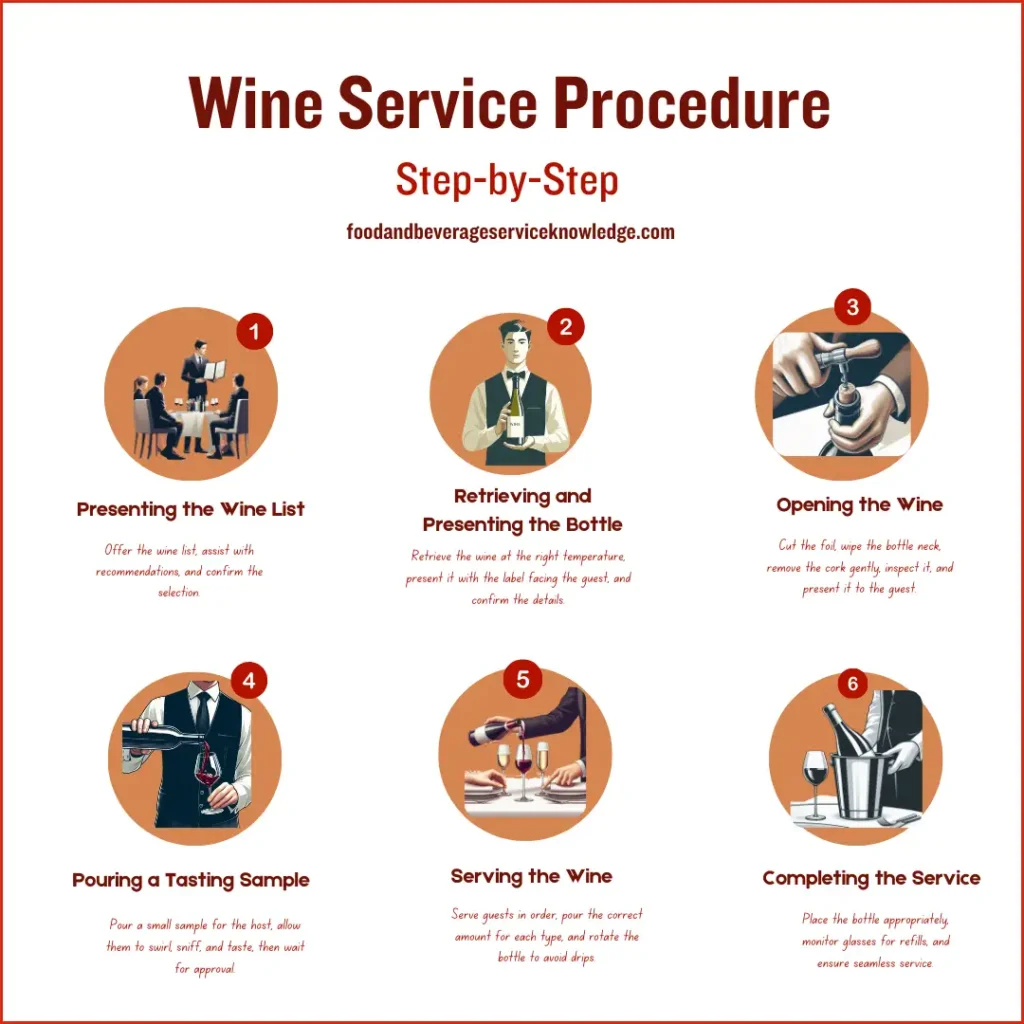
Essential Factors in Wine Service
To deliver impeccable wine service, there are key elements every professional must understand and manage effectively:
1. Wine Knowledge: Understanding the types of wine—red, white, rosé, sparkling, and fortified—as well as grape varieties, regions, vintages, and flavour profiles helps in recommending and serving the right wine.
2. Food and Wine Pairing: Knowledge of classic pairings (e.g., red wine with red meat, white wine with seafood) allows professionals to enhance a guest’s dining experience.
3. Storage: Wines must be stored horizontally (to keep corks moist), at proper temperatures, and away from light and vibration.
4. Guest Interaction: Active listening, suggesting suitable wines, and respecting guest preferences are crucial for creating rapport and trust.
Choosing the Right Glassware
Glassware influences the aroma, temperature, and taste of wine. The correct glass enhances the characteristics of the wine:
| Wine Type | Recommended Glass Shape | Purpose |
|---|---|---|
| Red Wine | Large, wide bowl (Bordeaux/Burgundy) | Allows oxidation and aroma release |
| White Wine | Smaller, narrower bowl | Preserves freshness and aroma |
| Sparkling Wine | Flute or tulip-shaped | Retains bubbles and visual appeal |
| Rosé Wine | Slightly flared rim | Enhances crispness |
| Dessert Wine | Small glasses | Concentrates sweetness and aroma |
Understanding the different types of glassware can further enhance the wine’s bouquet and taste.
Serving Wine at the Right Temperature
Each wine type has an ideal serving temperature that enhances its flavour and aroma:
| Wine Type | Temperature Range |
|---|---|
| Sparkling Wines | 5–10°C (41–50°F) |
| White & Rosé Wines | 7–14°C (45–57°F) |
| Light-bodied Reds | 12–17°C (54–63°F) |
| Full-bodied Reds | 17–21°C (63–70°F) |
| Dessert Wines | 10–12°C (50–54°F) |
For more detailed insights into serving temperatures and sensory techniques, visit Wikipedia’s Wine Tasting page. This resource offers scientific and historical context beyond practical service steps.
Enhance your wine service skills with this visual step-by-step guide to professional wine service in fine dining. Watch the full video below for clear demonstrations of red, white, and sparkling wine service techniques.
Wine Service Procedure: Step-by-Step
Wine service is more than just pouring a drink—it’s a ritual of elegance, expertise, and guest-centred care. For sommeliers and service staff, delivering flawless wine service enhances the guest’s dining experience and elevates the prestige of the restaurant. For a comprehensive overview of the full dining sequence, see our guide on the sequence of service in restaurants.
This complete guide walks through every stage of wine service, covering tools, techniques, etiquette, and temperature management for still, sparkling, red, and white wines.
Step 1: Presenting the Wine List
Presenting the wine list is more than a formality—it’s the beginning of a personalised experience. Your goal is to make the guest feel guided, not pressured, while helping them find a wine that complements both their taste and their meal.
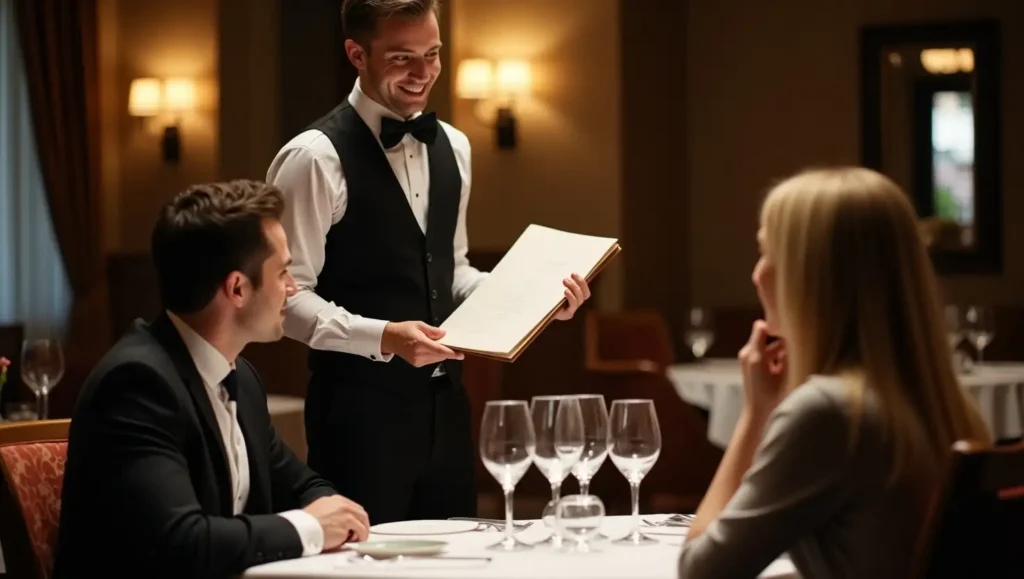
Approach and Presentation
Begin by approaching the guest from their right side, maintaining eye contact and a warm, attentive demeanour. Present the wine list with both hands or your right hand, showing care and respect for the guest’s dining experience. Ensure that the list is clean, updated, and well-organised, reflecting the professionalism of your establishment.
Introduce the wine list confidently, with a simple and polite invitation:
“May I offer you our wine selection this evening?”
Engaging the Guest
Engagement is key. Don’t just hand over the list—guide the guest based on their preferences and comfort level. You might ask:
- “Do you prefer red, white, or sparkling wines?”
- “Are you looking for something light or full-bodied?”
- “Would you like a recommendation to pair with your meal?”
As the guest responds, listen attentively and offer thoughtful suggestions. For example:
“A crisp Sauvignon Blanc would pair beautifully with your seafood—it balances acidity and enhances freshness.”
If your venue features sommelier specials, limited editions, or recommended pairings, this is a great time to highlight them, without pushing expensive options.
Describing the Wine
When discussing specific wines, use simple, approachable language. Describe key elements such as:
- Grape varietal (e.g., Cabernet Sauvignon, Pinot Grigio)
- Style (e.g., dry, sweet, oaky, fruity)
- Region (e.g., Bordeaux, Napa Valley)
- Flavor profile (e.g., notes of citrus, blackcurrant, vanilla)
Avoid technical jargon unless you’re sure the guest will appreciate it. Focus instead on connecting the wine to their taste or dining choice.
Sommelier’s Tip:
The best wine recommendations begin with listening, not listing. Tune into the guest’s tone, preferences, and cues—they’ll tell you more than their words ever could.n starts with listening, not listing.
Step 2: Receiving the Wine Order
Once the guest has selected a wine, your next responsibility is to ensure that the order is accurately received and clearly confirmed. This is a critical step—mistakes here can lead to costly errors and disrupt the flow of service.
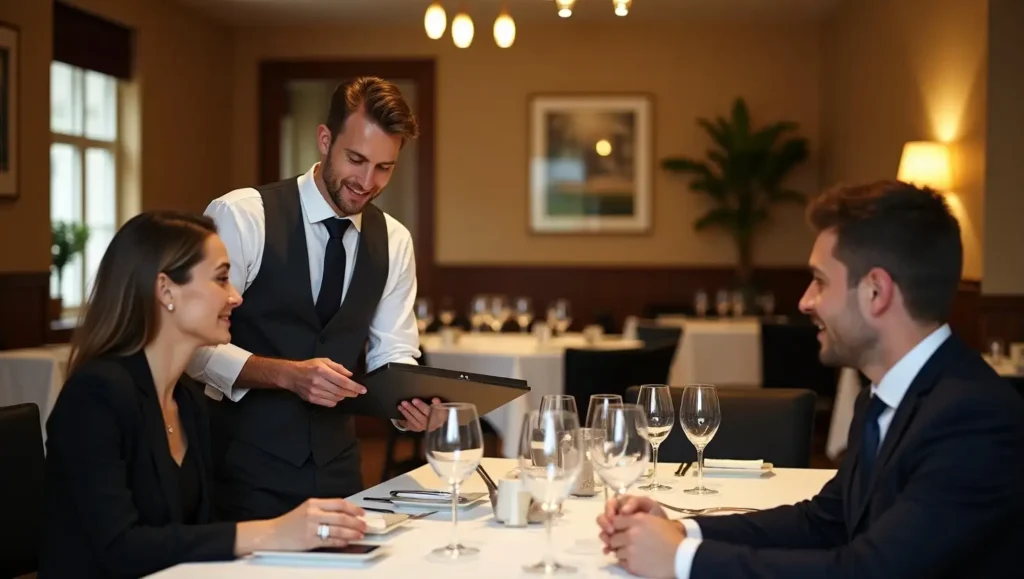
Confirming the Order Details
After the guest places their wine order, repeat it back clearly and confidently. This serves two purposes: it confirms that you’ve understood the request correctly and reassures the guest of your attention to detail.
Include all key details when repeating the order:
- Producer or Brand (e.g., Robert Mondavi, Cloudy Bay)
- Grape Varietal (e.g., Chardonnay, Shiraz)
- Region or Appellation (e.g., Marlborough, Chianti Classico)
- Vintage (e.g., 2020, 2018)
- Bottle Size (e.g., 750ml standard, magnum)
“Just to confirm, that’s the 2019 Chianti Classico Riserva from Castello di Ama, 750ml?”
If any part of the order is unclear, especially the vintage or producer, politely ask for clarification:
“Would you prefer the 2019 or 2020 vintage of the Chianti Classico?”
Handling Out-of-Stock Wines
If the requested wine is unavailable, apologise sincerely and handle the situation gracefully:
“I’m terribly sorry, that wine is currently unavailable. However, I’d be happy to suggest a similar option with a comparable style and price.”
When offering alternatives, match the flavour profile, region, or body of the original request. Avoid upselling unless the guest expresses interest in exploring something different.
Identifying the Host
Quietly identify the host or the person who placed the order, as they will typically be the one presented with the bottle and offered the tasting. This can be done discreetly by observing who gave the order or gently confirming if needed.
Professional Reminder:
This step sets the foundation for smooth service. A precise wine order eliminates confusion and ensures that what arrives at the table matches what the guest expects—every time.
Learn more about proper wine storage conditions—including humidity, temperature, and bottle positioning—from Wine Enthusiast’s wine storage guide.
Thanks for sharing your content—it’s already strong and informative! To integrate your section on “Presenting and Opening the Wine” smoothly into your blog post, I’ll revise and enrich it by:
- Refining the language for clarity and flow.
- Adding a “Presenting the Wine” sub-section before opening.
- Enhancing professionalism with subtle details appreciated by hotel management students and F&B professionals.
- Maintaining consistency with your existing blog’s tone.
Step 4: Presenting and Opening the Wine
Once the wine has been selected and ordered, the service ritual begins with presenting and opening the bottle—a refined act that blends professionalism, etiquette, and showmanship. This process should be smooth, quiet, and precise, enhancing the guest experience without drawing unnecessary attention.
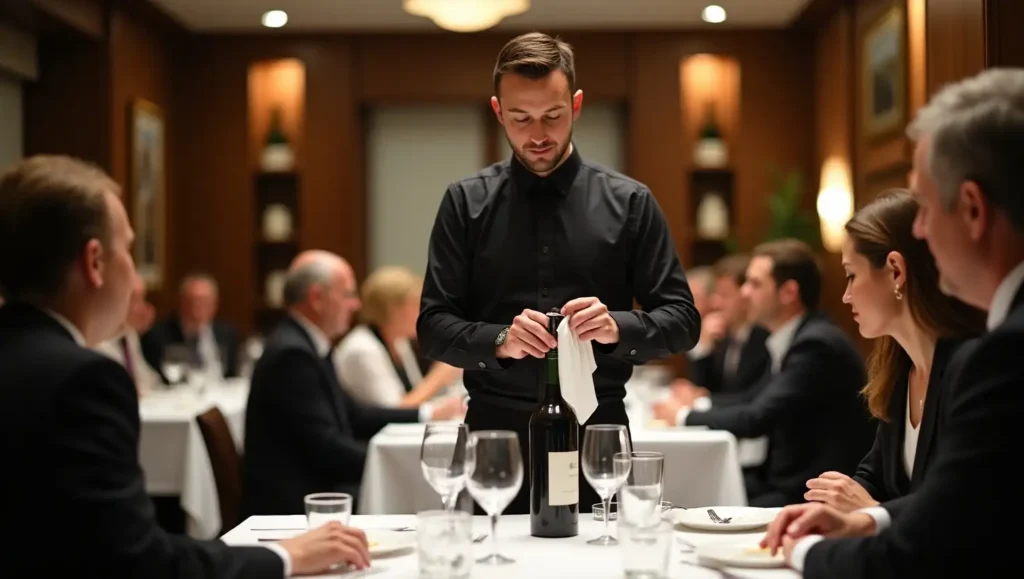
Presenting the Wine
Before opening, always present the bottle to the host (the guest who ordered it) for confirmation. This step ensures the correct bottle is being served and gives the guest a moment to verify the label.
Follow these steps:
- Hold the bottle with the label clearly facing the host, cradling it with both hands or presenting from the right side with the label visible.
- Announce the wine by stating the name, vintage, and region, e.g., “Sir/Madam, your Château Margaux 2015, from Bordeaux.”
- Await verbal confirmation or a nod from the host before proceeding to open the wine.
Pro Tip: Present with confidence but avoid interrupting the conversation at the table.
Opening Still Wines (Red or White)
Opening a bottle of still wine requires grace, attention to detail, and a silent mastery of the sommelier’s tools.
Steps:
- Cut the foil neatly just below the lip using a foil cutter or the small knife on a sommelier’s corkscrew. This prevents contact between the wine and the foil while pouring.
- Wipe the neck with a clean napkin to remove dust or debris.
- Insert the corkscrew into the centre of the cork and rotate it about 5–6 full turns.
- Extract the cork silently and steadily using a double-hinged corkscrew for enhanced control.
- Inspect the cork discreetly for damage, dryness, or mould, which may indicate spoilage.
- Offer the cork to the host on a small plate or clean napkin (optional, but common in fine dining).
- Wipe the bottle neck again before pouring to remove cork residue or dust.
Professional Tip: Your hands should remain steady. Maintain eye contact with the host briefly before proceeding, but avoid dramatic gestures.
Opening Sparkling Wines (Champagne, Prosecco, Cava)
Sparkling wines are under pressure and require special handling to open safely and gracefully.
Steps:
- Keep your thumb on the cork once the foil is removed to prevent unexpected ejection.
- Remove the foil entirely and gently loosen the wire cage.
- Hold the bottle at a 45° angle, pointing away from guests, tableware, and yourself.
- Twist the bottle (not the cork) slowly, allowing the cork to ease out with a gentle hiss, not a pop.
- Wipe the neck with a clean napkin before pouring.
Service Etiquette: A quiet hiss indicates control and respect for the dining atmosphere. Loud cork pops, while festive, are generally avoided in fine restaurants.
Temperature & Equipment Notes
- Still white and sparkling wines should be served chilled (8–12°C / 46–54°F).
- Use an ice bucket filled with ice and water for even chilling.
- After each pour, return the bottle to the chiller to maintain proper serving temperature.
Pro Tip: A thermometer or infrared wine temperature scanner can help ensure precise service temperatures—especially in high-end venues.
Step 5: Offering the Tasting
The wine tasting step is a moment of quiet ceremony. It allows the host—the person who ordered the wine—to verify that the wine is in good condition, not whether they personally like the taste. This distinction is essential in professional wine service.
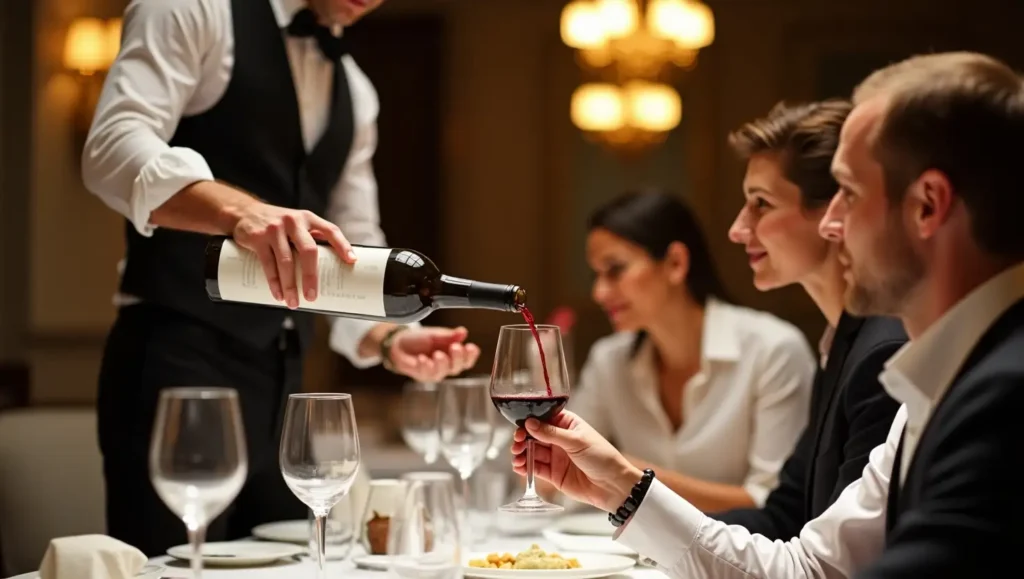
Purpose of the Tasting
The tasting portion is presented to ensure:
- The wine is not corked (faulty cork affecting aroma or taste)
- The wine is not oxidised or spoiled
- The correct wine, vintage, and bottle are served as ordered
It is not for the guest to decide whether they “like” the wine’s flavour—that’s what the selection process is for.
Proper Execution
- Pour a tasting portion—around 30–50 ml (1–2 ounces)—into the host’s glass.
- Stand back slightly, maintaining an elegant and respectful posture. Give the host space and a moment of quiet to observe, swirl, smell, and taste the wine.
- Watch for approval—look for subtle cues such as:
- A nod
- A smile
- A verbal confirmation, such as “That’s fine, thank you.”
- Once approved:
- Politely thank the host
- Proceed to serve the remaining guests in the proper order (covered in Step 6)
If the Wine is Declined
Sometimes, the guest may detect a fault and reject the wine. In this case:
- Accept the decision graciously, with no hesitation or challenge.
“I completely understand. Allow me to bring you a fresh bottle.”
- Apologise sincerely and remove the bottle discreetly.
- Offer a replacement of the same wine, or if requested, assist in choosing an alternative.
Important Distinction:
This is a quality check, not a preference check. Even if the guest dislikes the taste, as long as the wine is sound, it is not typically returned. However, professional discretion and guest satisfaction should guide your response, whether the guest enjoys the flavour.
Step 6: Pouring for the Guests
Once the host has approved the wine, it’s time to serve each guest with refined technique, consistent etiquette, and a graceful presence. This stage combines precision with hospitality, ensuring every guest enjoys the wine at its best.
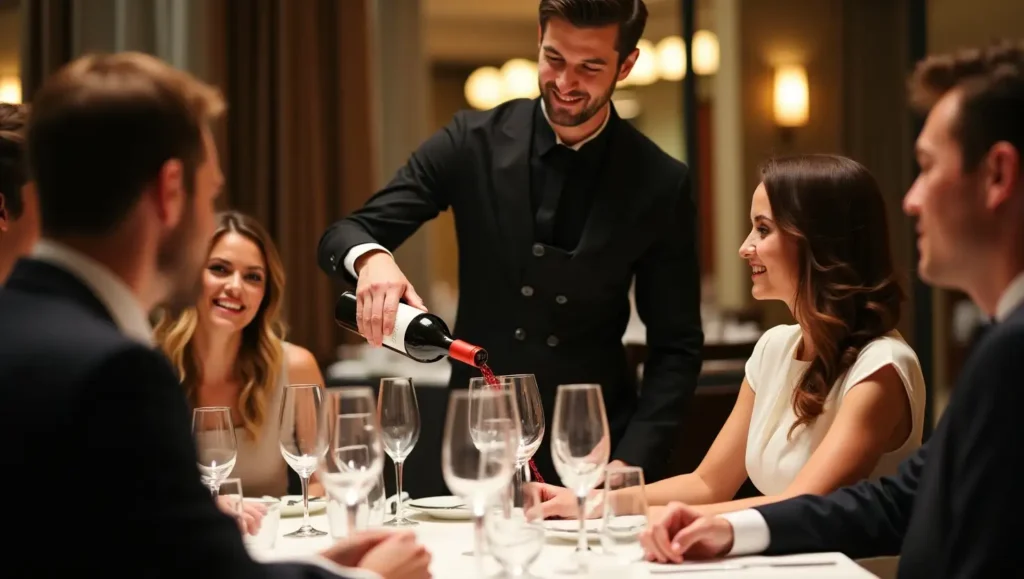
Serving Order
Follow the appropriate serving protocol based on the occasion:
- Traditional service:
- Ladies first
- Gentlemen next
- Host last
- Formal or corporate settings:
Follow the order of seniority, guest-of-honour status, or the host’s indication.
Always move clockwise around the table unless local customs dictate otherwise.
Pouring Technique
- Hold the bottle:
- By the lower half or base, with a confident grip.
- Alternatively, cradle it in a folded napkin to add elegance and protect from drips.
- Label facing out:
Ensure the wine label is always visible to the guest while pouring—this reinforces transparency and presentation. - Pour slowly and smoothly, according to wine type:
- Red wine: Fill to the widest part of the glass bowl (about 1/3 to 1/2 full).
- White wine: Pour slightly less than red wine to help retain its chill.
- Sparkling wine: Pour gently in two stages—a small amount first to control foam, then top up gradually.
- Prevent drips:
Finish each pour with a subtle wrist twist, and wipe the bottle lip with your napkin after every few servings or as needed.
Glassware Tip
Using the right glass enhances the wine’s aroma and flavour:
- Red wine: Larger, rounder bowls to promote aeration
- White wine: Smaller, narrower bowls to retain freshness
- Sparkling wine: Flute or tulip glasses to maintain bubbles and concentrate aromas
Sommelier’s Note:
Every pour should feel effortless. Your focus isn’t just filling glasses—it’s curating a seamless guest experience.
Step 7: Monitoring and Maintaining Wine Service
Serving wine doesn’t end after the initial pour. Ongoing wine service requires discretion, attentiveness, and the ability to anticipate guest needs, without interrupting their experience.
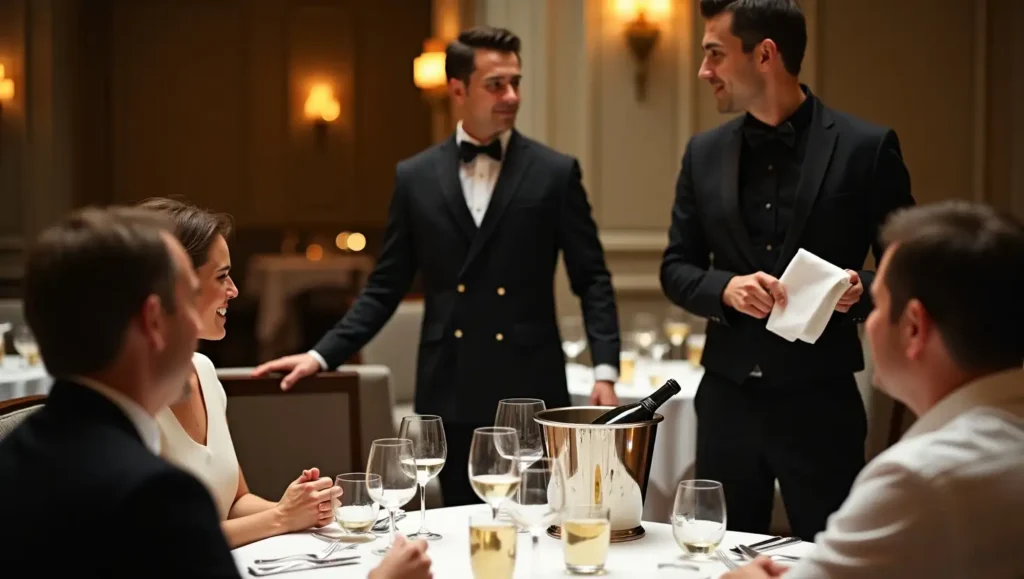
This is where service transforms from good to exceptional.
Your Objective
- Keep wine glasses consistently filled—never too low, never too full.
- Maintain the proper temperature, especially for white and sparkling wines.
- Do so quietly and smoothly, preserving the flow of the guest’s conversation and enjoyment.
How to Execute Elegant Ongoing Service
Observe Discreetly
- Position yourself where you can see glass levels without hovering.
- Pay attention to body language and eye contact—guests often give subtle cues.
Refill at the Right Moment
- Top up glasses when they are about one-third full.
- Avoid topping up too frequently; this can disrupt the pace of drinking and conversation.
- Never interrupt a conversation—wait for a natural pause before stepping in.
Respect Non-Verbal Cues
- If a guest covers their glass with their hand or places it away from the table edge, it usually means “No more, thank you.”
- Respect this silently—never insist.
Maintain Temperature
- For white and sparkling wines:
- Always return the bottle to an ice bucket between pours.
- Keep the ice bucket within reach of service staff, not the guests.
Handling a Second Bottle
- If the guest orders another bottle—even of the same wine—treat it like a new order:
- Present the bottle
- Confirm the label and vintage
- Offer a fresh taste to the host
Sommelier Insight:
The finest wine service goes unnoticed—because it is so fluid and flawless that it never draws attention. Your presence should be felt through precision, not performance.
In upscale restaurants, wine service may incorporate elegant gueridon service techniques for a premium guest experience.
FAQs About Wine Service
1. Who is responsible for wine service in a restaurant?
In fine dining or upscale establishments, a sommelier is typically responsible for wine service. In other settings, trained waitstaff or beverage stewards may handle the task.
2. What is the correct serving temperature for wine?
Red Wine: 15–18°C (59–64°F)
White Wine: 7–12°C (45–54°F)
Sparkling Wine & Champagne: 5–8°C (41–46°F)
Proper temperature enhances aroma, flavour, and overall experience.
3. Why is wine poured for tasting before serving?
A small amount is poured for the host to evaluate the wine’s condition, checking for faults like cork taint or oxidation. It’s not to decide if they simply like the wine.
Related Articles:
This article was written by Saswata Banerjee, the creator of Food and Beverage Service Knowledge, based on 8+ years of experience in the hospitality industry.


